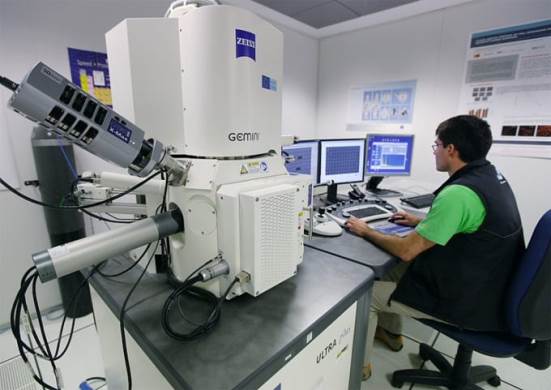Validation of optical measurement technologies
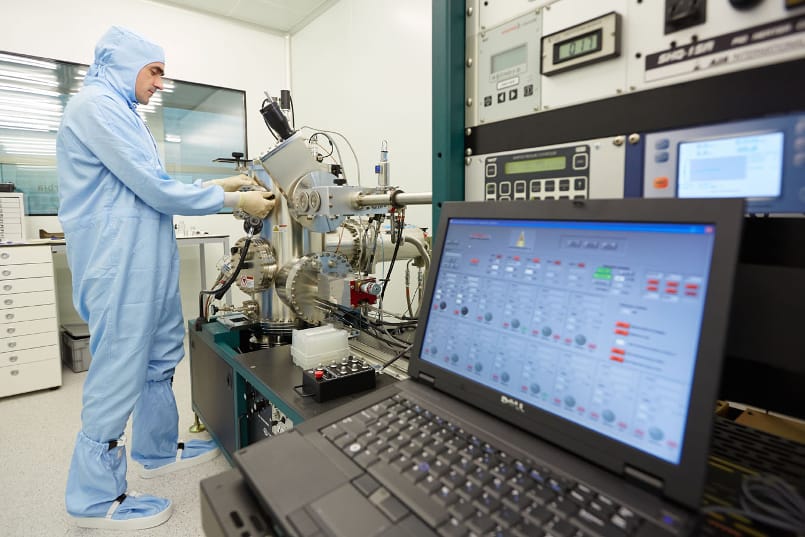
TEKNIKER is carrying out research based on the micro and nanostructuring of components focused on applications in diverse fields, such as optical linear and angle encoders or label-free photonic biosensors.
The label-free photonic biosensors developed are based on two separate principles, although both are linked to the presence of nanostructures. Thus, biosensors based on both DFB lasers (Distributed Feedback) and on LSPR (Localised Surface Plasmon Resonance) have been developed.
These sensors are minimally invasive, given that markers for detecting a biomolecule in question (biomarkers) are not necessary. Moreover, the quantity of sample required for its detection is very small.
In both cases, both DFB lasers and LSPR, in order to ensure the sensing of the target biomolecule and not of any other that may be present in the sample, the nanostructured surfaces are biofuntionalize with the specific antibody for the biomarker.
The main developments currently being undertaken are focused on biomedicine and optical biosensors, but these devices can be adapted to the quality control for lubricating oils, for the automobile and the machine tools sectors, as well as in aeronautics.
Related contents
- Array ( [id] => 54 [idcategoria] => 4 [idsubcategoria] => [imagen] => 03_AI_IP_Validacion_Tecnologias_Medida_Opticas.jpg [caso_exito_1] => 37 [caso_exito_2] => 62 [caso_exito_3] => [cliente_1] => [cliente_2] => [cliente_3] => [direcciones_email] => consultasweb@tekniker.es [titulo] => Validation of optical measurement technologies [video] => [texto_1] =>
- Scanning electronic microscope with field emission gun using a GEMINI column for high resolution and analysis
- Resolution from 0.8 nm to 4.0 nm depending on the kV used
- Acceleration voltage from 0.02 V to 30 kV
- Up to 1,000,000 magnification
- 5 apertures: 10 μm, 20 μm, 30 μm, 60 μm and 120 μm
- Maximum sample weight: 0.5 Kg
- Charge compensator for avoiding charging of conducting materials
- Various kinds of detectors (Inlens, SE, AsB, ESB, EDS, EBSD)
- Study of micro and nanostructured surfaces and profiles
- Fractography and microanalysis
- Characterisation of metallic particles for the metal recycling industry
- Optical characterisation of chips at a nanometric scale
- Characterisation of biological and non-biological materials
- Dimensional characterisation of samples by contact using styli of 5 µm, 0.7 µm and 50 nm radii or, with a vertical range of measurement from 50 Å to 262 µm and a resolution of up to 1 µm
- Control of thermoplastic thicknesses during the manufacturing process
- Nanoimprinting lithography processes (structuring of semiconductors, glass, and so on), and of hot embossing (structuring of polymers) with a resolution of up to tens of nm
- Nanostructure transfer of the mould to the surface on which these nanostructures are being manufactured
- Dimensional characterisation of samples with a vertical range of measurement of up to 1 µm and a resolution of 1nm
- Contact and semi-contact measurement modes
- Precision measurements of nanostructures on polymers for optimising and guaranteeing the repeatability of the manufacturing process
- Physical-chemical attack using reactive semiconductor plasmas (such as silicon), dielectrics (silicon oxide and nitride) and organic (polymer) substrates
- Capacity for attack from a few nm up to tens of µm (Bosch)
- Polymer attack for manufacturing
- Metal coatings (Pt, Au, Cr. Ti, elh)
- E-Beam deposition (Ti + Au) – deposition of thin metal coatings in a controlled and uniform manner (control of thickness in nm) and low roughness
- Automated cutting of wafers of silicon and glass of up to 4’’ and 1 mm of thickness
- For cutting wafers and substrates, to the dimensions required by the microfluidic cell (and sensor device), made-to-measure chips
- Photolithography processes on substrates of up to 6’’
- Precision in the alignment and resolution of exposure up to 1 µm
- Exposure with collimated UV light in the range of 350-450 nm
- Alignment for cutting wafers and substrates, to the dimensions required by the microfluidic cell (and sensor device), made-to-measure chips
TEKNIKER is carrying out research based on the micro and nanostructuring of components focused on applications in diverse fields, such as optical linear and angle encoders or label-free photonic biosensors.
[fase_1] => [fase_2] => [fase_3] => [fase_4] => [texto_2] =>The label-free photonic biosensors developed are based on two separate principles, although both are linked to the presence of nanostructures. Thus, biosensors based on both DFB lasers (Distributed Feedback) and on LSPR (Localised Surface Plasmon Resonance) have been developed.
These sensors are minimally invasive, given that markers for detecting a biomolecule in question (biomarkers) are not necessary. Moreover, the quantity of sample required for its detection is very small.
In both cases, both DFB lasers and LSPR, in order to ensure the sensing of the target biomolecule and not of any other that may be present in the sample, the nanostructured surfaces are biofuntionalize with the specific antibody for the biomarker.
The main developments currently being undertaken are focused on biomedicine and optical biosensors, but these devices can be adapted to the quality control for lubricating oils, for the automobile and the machine tools sectors, as well as in aeronautics.
[texto_tabla] => [enlace_flickr] => https://www.flickr.com/photos/teknikerik4/sets/72157650366476838/ [enlace_youtube] => https://www.youtube.com/playlist?list=PLdI9ptv1PWEyxz5WePdQBOVboeyAziGi5 [enlace_issuu] => [enlace_slideshare] => [seo_h1] => Validation of optical measurement technologies [seo_url] => validation-of-optical-measurement-technologies [seo_title] => Validation of optical measurement technologies - TEKNIKER [seo_desc] => TEKNIKER is carrying out research based on the micro and nanostructuring of components focused on applications in diverse fields. [imagenes] => [enlaces] => Array ( [0] => Array ( [imagen] => [titulo] => Universidad de Cantabria (UC) [texto_corto] => [enlace] => http://web.unican.es/en/Pages/default.aspx [alt] => Universidad de Cantabria (UC) ) [1] => Array ( [imagen] => [titulo] => Universitat d´ Alacant (UA) [texto_corto] => [enlace] => http://www.ua.es/en/ [alt] => Universitat d´ Alacant (UA) ) [2] => Array ( [imagen] => [titulo] => Proteomika [texto_corto] => [enlace] => http://www.proteomika.com/index.php?lang=en [alt] => Proteomika ) [3] => Array ( [imagen] => [titulo] => Instituto de Microelectrónica de Madrid (CNM – CSIC) [texto_corto] => [enlace] => http://www.imm.cnm.csic.es/en [alt] => Instituto de Microelectrónica de Madrid (CNM – CSIC) ) [4] => Array ( [imagen] => [titulo] => IDIVAL – Instituto de investigación sanitaria de Valdecilla [texto_corto] => [enlace] => http://www.idival.org/Es/Paginas/Inicio.aspx [alt] => IDIVAL – Instituto de investigación sanitaria de Valdecilla ) [5] => Array ( [imagen] => [titulo] => CELLBIOCAN [texto_corto] => [enlace] => http://www.cellbiocan.com/ [alt] => CELLBIOCAN ) [6] => Array ( [imagen] => [titulo] => Grupo TIRSO [texto_corto] => [enlace] => http://tirso.org/ [alt] => Grupo TIRSO ) [7] => Array ( [imagen] => [titulo] => NanoGUNE [texto_corto] => [enlace] => http://www.nanogune.eu/en [alt] => NanoGUNE ) [8] => Array ( [imagen] => [titulo] => Instituto de Microelectrónica de Barcelona (IMB-CNM) [texto_corto] => [enlace] => http://www.imb-cnm.csic.es/index.php/en/ [alt] => Instituto de Microelectrónica de Barcelona (IMB-CNM) ) [9] => Array ( [imagen] => [titulo] => SECPhO – Southern European Cluster in Photonics and Optics [texto_corto] => [enlace] => http://www.secpho.org/ [alt] => SECPhO – Southern European Cluster in Photonics and Optics ) [10] => Array ( [imagen] => [titulo] => innoFSPEC [texto_corto] => [enlace] => http://www.innofspec.de/en/ [alt] => innoFSPEC ) [11] => Array ( [imagen] => [titulo] => DTU Nanotech (Technical University of Denmark, Department of Micro- and Nanotechnology) [texto_corto] => [enlace] => http://www.nanotech.dtu.dk/english [alt] => DTU Nanotech (Technical University of Denmark, Department of Micro- and Nanotechnology) ) ) [publicaciones] => Array ( [0] => Array ( [titulo] => Dispositivo y método para la detección de biomarcadores [enlace] => en/inventions#PCT-ES2014-070215 ) [1] => Array ( [titulo] => Biosensing for disease monitoring: metallic nanohole array plasmonic sensors based on scalable nanofabrication techniques [enlace] => biosensing-for-disease-monitoring-metallic-nanohole-array-plasmonic-sensors-based-on-scalable-nanofabrication-techniques ) [2] => Array ( [titulo] => Dispositivo para la detección de una única molécula en situación de nanoconfinamiento y en régimen dinámico, procedimiento de fabricación y uso [enlace] => en/inventions#P201330922 ) [3] => Array ( [titulo] => Surface plasmon resonance immunoassay for the detection of the TNF alpha biomarker in human serum [enlace] => surface-plasmon-resonance-immunoassay-for-the-detection-of-the-tnf-alpha-biomarker-in-human-serum ) [4] => Array ( [titulo] => Thermal-nanoimprint lithography for perylenediimide-based distributed feedback laser fabrication, [enlace] => thermal-nanoimprint-lithography-for-perylenediimide-based-distributed-feedback-laser-fabrication ) [5] => Array ( [titulo] => Real-Time Label-Free Surface Plasmon Resonance Biosensing with Gold Nanohole Arrays Fabricated by Nanoimprint Lithography [enlace] => real-time-label-free-surface-plasmon-resonance-biosensing-with-gold-nanohole-arrays-fabricated-by-nanoimprint-lithography ) [6] => Array ( [titulo] => Improved performance of perylenediimide-based lasers [enlace] => improved-performance-of-perylenediimide-based-lasers ) [7] => Array ( [titulo] => Perylenediimide-based distributed feedback lasers with holographic relief gratings on dichromated gelatine [enlace] => perylenediimide-based-distributed-feedback-lasers-with-holographic-relief-gratings-on-dichromated-gelatine ) ) [sectores] => Array ( [0] => Array ( [titulo] => Aeronautics and space [seo_url] => aeronautics-and-space [imagen] => aeronautica.svg ) [1] => Array ( [titulo] => Automotive [seo_url] => automotive [imagen] => automocion.svg ) [2] => Array ( [titulo] => Machine tools and manufacturing [seo_url] => machine-tools-and-manufacturing [imagen] => maquina_herramienta.svg ) ) [soluciones] => Array ( [0] => Array ( [titulo] => Sensor devices [seo_url] => sensor-devices [imagen] => ST_DispositivosSensores_808x450px_icono.jpg ) ) [equipamiento] => Array ( [0] => Array ( [id] => 42 [titulo] => Scanning electronic microscope (SEM) [imagen] => Microscopio_electrónico_de_barrido__SEM1.JPG [texto] =>CHARACTERISTICS OF THE EQUIPMENT
EXPERTISE
CHARACTERISTICS OF THE EQUIPMENT
EXPERTISE
CHARACTERISTICS OF THE EQUIPMENT
EXPERTISE
CHARACTERISTICS OF THE EQUIPMENT
EXPERTISE
CHARACTERISTICS OF THE EQUIPMENT
EXPERTISE
CHARACTERISTICS OF THE EQUIPMENT
EXPERTISE
CHARACTERISTICS OF THE EQUIPMENT
EXPERTISE
CHARACTERISTICS OF THE EQUIPMENT
EXPERTISE
) ) )
Industrial sectors
Singular equipment
- Scanning electronic microscope (SEM)
Scanning electronic microscope (SEM)
CHARACTERISTICS OF THE EQUIPMENT
- Scanning electronic microscope with field emission gun using a GEMINI column for high resolution and analysis
- Resolution from 0.8 nm to 4.0 nm depending on the kV used
- Acceleration voltage from 0.02 V to 30 kV
- Up to 1,000,000 magnification
- 5 apertures: 10 μm, 20 μm, 30 μm, 60 μm and 120 μm
- Maximum sample weight: 0.5 Kg
- Charge compensator for avoiding charging of conducting materials
- Various kinds of detectors (Inlens, SE, AsB, ESB, EDS, EBSD)
EXPERTISE
- Study of micro and nanostructured surfaces and profiles
- Fractography and microanalysis
- Characterisation of metallic particles for the metal recycling industry
- Optical characterisation of chips at a nanometric scale
- Characterisation of biological and non-biological materials
- Mechanical profilometer
Mechanical profilometer
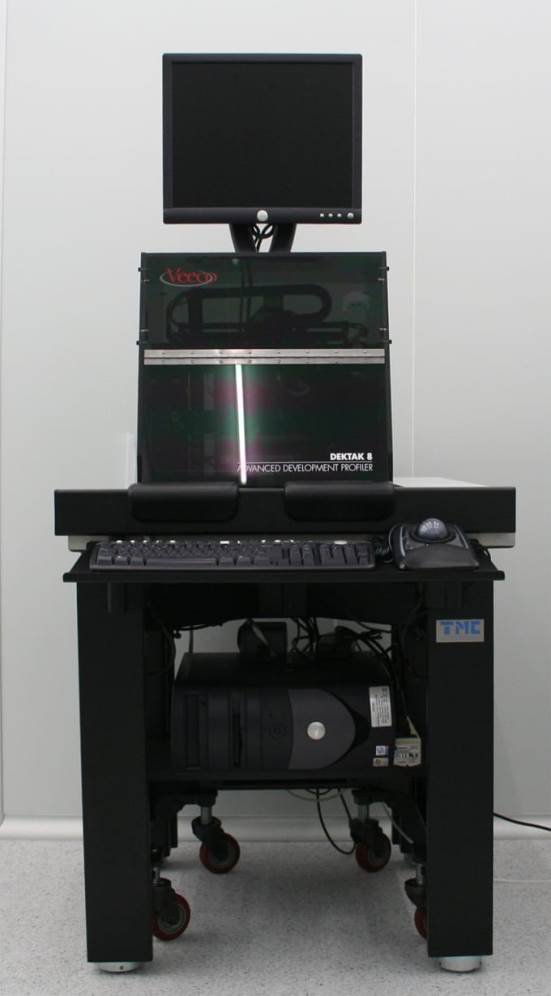
CHARACTERISTICS OF THE EQUIPMENT
- Dimensional characterisation of samples by contact using styli of 5 µm, 0.7 µm and 50 nm radii or, with a vertical range of measurement from 50 Å to 262 µm and a resolution of up to 1 µm
EXPERTISE
- Control of thermoplastic thicknesses during the manufacturing process
- Nanoimprinting/hot embossing equipment
Nanoimprinting/hot embossing equipment
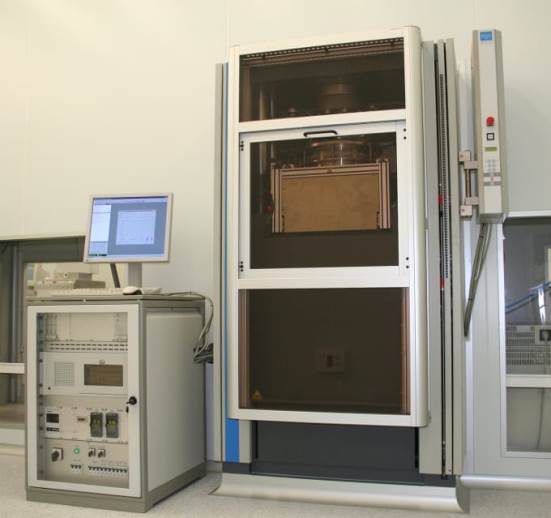
CHARACTERISTICS OF THE EQUIPMENT
- Nanoimprinting lithography processes (structuring of semiconductors, glass, and so on), and of hot embossing (structuring of polymers) with a resolution of up to tens of nm
EXPERTISE
- Nanostructure transfer of the mould to the surface on which these nanostructures are being manufactured
- Atomic force microscope
Atomic force microscope
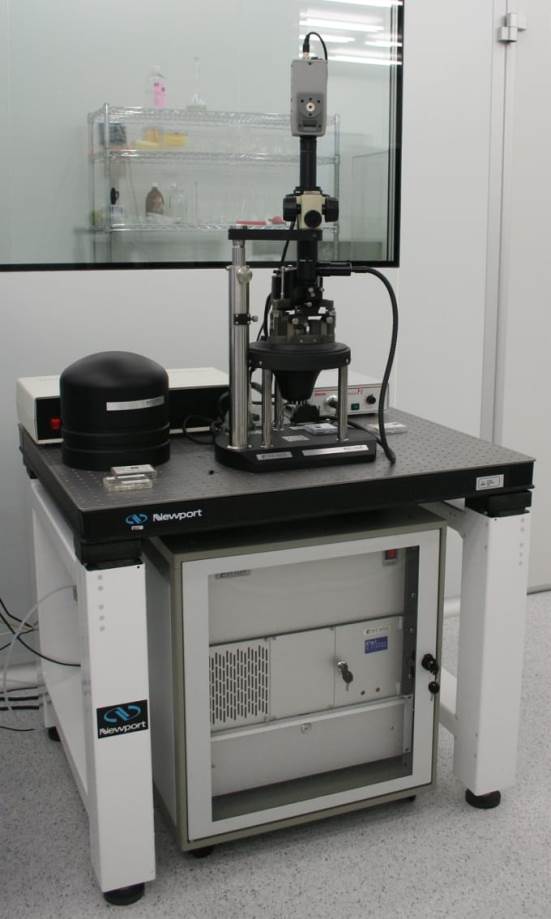
CHARACTERISTICS OF THE EQUIPMENT
- Dimensional characterisation of samples with a vertical range of measurement of up to 1 µm and a resolution of 1nm
- Contact and semi-contact measurement modes
EXPERTISE
- Precision measurements of nanostructures on polymers for optimising and guaranteeing the repeatability of the manufacturing process
- DRIE (Deep Reactive Ion Etching) equipment
DRIE (Deep Reactive Ion Etching) equipment
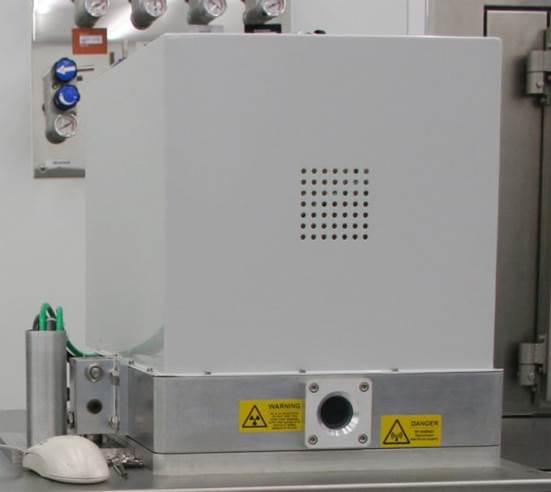
CHARACTERISTICS OF THE EQUIPMENT
- Physical-chemical attack using reactive semiconductor plasmas (such as silicon), dielectrics (silicon oxide and nitride) and organic (polymer) substrates
- Capacity for attack from a few nm up to tens of µm (Bosch)
EXPERTISE
- Polymer attack for manufacturing
- E-BEAM deposition
E-BEAM deposition
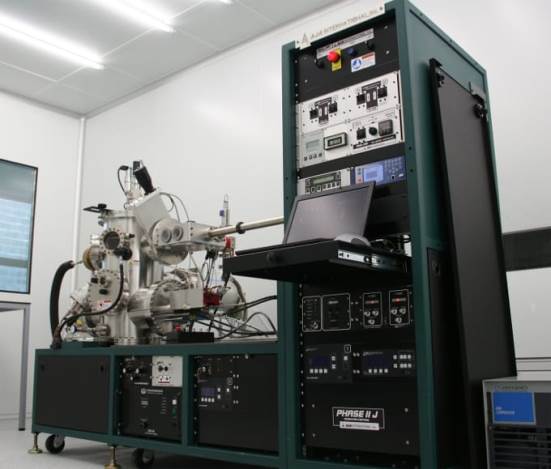
CHARACTERISTICS OF THE EQUIPMENT
- Metal coatings (Pt, Au, Cr. Ti, elh)
EXPERTISE
- E-Beam deposition (Ti + Au) – deposition of thin metal coatings in a controlled and uniform manner (control of thickness in nm) and low roughness
- Cutting tool
Cutting tool
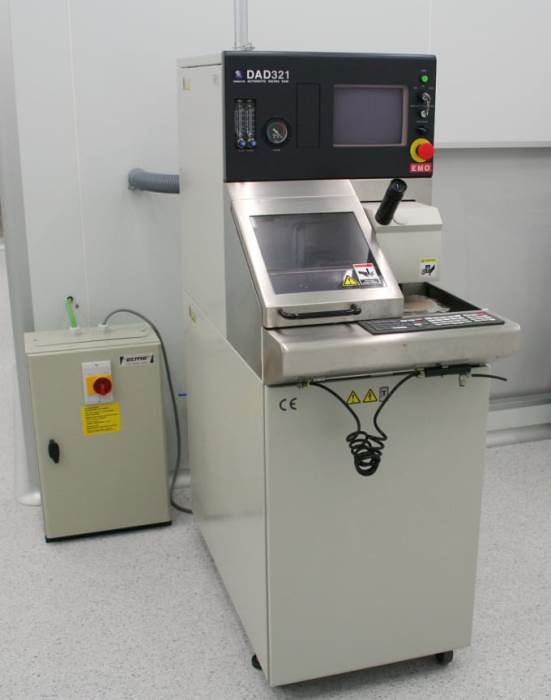
CHARACTERISTICS OF THE EQUIPMENT
- Automated cutting of wafers of silicon and glass of up to 4’’ and 1 mm of thickness
EXPERTISE
- For cutting wafers and substrates, to the dimensions required by the microfluidic cell (and sensor device), made-to-measure chips
- Mask aligners
Mask aligners
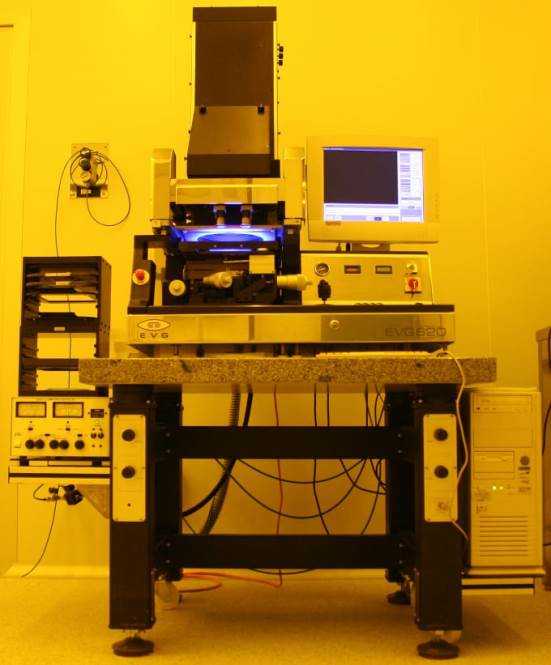
CHARACTERISTICS OF THE EQUIPMENT
- Photolithography processes on substrates of up to 6’’
- Precision in the alignment and resolution of exposure up to 1 µm
- Exposure with collimated UV light in the range of 350-450 nm
EXPERTISE
- Alignment for cutting wafers and substrates, to the dimensions required by the microfluidic cell (and sensor device), made-to-measure chips
Case studies
Partners network
- Universidad de Cantabria (UC)
- Universitat d´ Alacant (UA)
- Proteomika
- Instituto de Microelectrónica de Madrid (CNM – CSIC)
- IDIVAL – Instituto de investigación sanitaria de Valdecilla
Scientific excellence
- Dispositivo y método para la detección de biomarcadores
- Biosensing for disease monitoring: metallic nanohole array plasmonic sensors based on scalable nanofabrication techniques
- Dispositivo para la detección de una única molécula en situación de nanoconfinamiento y en régimen dinámico, procedimiento de fabricación y uso
- Surface plasmon resonance immunoassay for the detection of the TNF alpha biomarker in human serum
- Thermal-nanoimprint lithography for perylenediimide-based distributed feedback laser fabrication,
- Real-Time Label-Free Surface Plasmon Resonance Biosensing with Gold Nanohole Arrays Fabricated by Nanoimprint Lithography
- Improved performance of perylenediimide-based lasers
- Perylenediimide-based distributed feedback lasers with holographic relief gratings on dichromated gelatine




